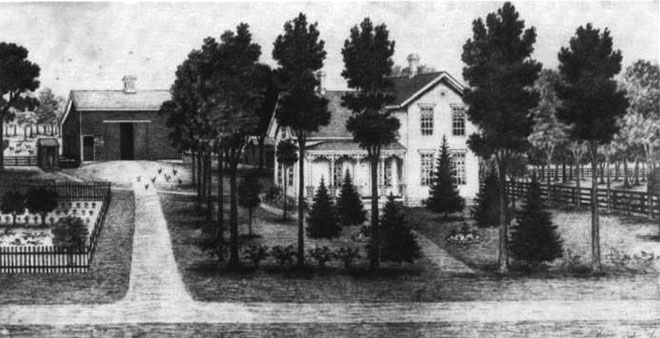Bizarre Belvidere The Esteemed Professor Stanley

COURTESY PHOTO Belvidere Republican
An illustration of the Ramsay family’s new farmhouse by Professor William Stanley.
In today’s Bizarre Belvidere, we will be moving out of the city a little and into the farmland of Belvidere Township and greater Boone County. Before that however, we have to take a trip out East.
Professor William Stanley was born to an upper class family in Pennsylvania. As a boy, he was studious and had a passion for the arts. He was talented enough to attend, graduate from and even teach at a “prestigious university.” Some accounts say it was Harvard, although they claim to have no record of him there.
The professor found his career to be too stressful so he opted to terminate his position and fill his days with artistic pursuits. Eventually, his family became so tired of this that, in 1885, when he expressed a desire to travel west to draw the scenery they paid for his travel immediately.
The professor’s allowance soon ran out and he had no choice but to make money somehow, so he travelled across Northern Illinois and Southern Wisconsin by selling his artistic talents. In exchange for room and board, Stanley would make detailed pencil drawings of the places he stayed.
He preferred the countryside to cities, so most of his art depicted farmhouses, barns, fields or churches. How large and how detailed his drawings were depended entirely on his host. If he enjoyed his accommodations, he could spend a month or more drawing a single location, although it usually took him about two weeks.
There were many ways to please the professor. Offering cash in addition to board certainly helped you get a better picture. Three good meals a day could add a few extra pencil strokes to your silo. At the end of the day though, the most important thing for him was to feel like a real guest.
Putting Stanley out in the “hired hand’s quarters” was the most offensive thing you could ever do, that and not calling him Professor. He demanded to sleep in not just any guestroom but the home’s very best guestroom. There’s even a story about him sneaking into another room in the middle of the night because he was upset about sleeping in a room he didn’t care for.
When a patron showed Stanley particular hospitality, he would make sure to return later. A blurb in the Belvidere Standard, from 1898, remarked that the professor was in Capron for his “yearly visit.” Some families housed him three times or more over the years.
However, not everyone was happy when Stanley came around. In a 1973 interview, published in the Belvidere Daily Republican, a man recalls his mother telling him and his sister to hide away from the windows, hoping that Stanley would move on to another home. Eventually, she had to bring out dinner for the workers in their field and the professor got his dinner too. When the paper announced Stanley’s arrival, it was a celebration for some and a warning for others.
Whether you enjoyed Stanley’s company or thought he was a nuisance, everyone agreed he was talented. It didn’t take him two weeks to draw a picture just because he wanted a few more free meals, although that was probably part of it. Stanley worked meticulously to accurately capture the details of his surroundings. He took measurements of all the buildings he drew, allowing him to draw with an impressive sense of scale.
All of Stanley’s drawings captured his subject as if he was on a hilltop, looking slightly down. As most of us know, there aren’t enough hills in Boone County for every barn to be observed from above. After taking his measurements, he would go back inside and envision the scene from his imaginary perspective.
Before photography was more commonplace, Professor Stanley’s drawings actually stood out as possibly the best rural property illustrations in the region. Although admittedly, competition was scarce. You would have had to pay a pretty penny to hire an artist or a photographer from Chicago if you wanted to commemorate your new farmhouse expansion.
Meanwhile, Stanley only cost a few extra meals and some laundry. There are quite a few early 20th century photographs of State Street and sometimes the town centers of smaller Boone communities, but there are very few visual records of farms and homesteads.
Illustration wasn’t the only means Stanley had to get by. There were times when he would seek out other artistic ventures to satiate himself and his wallet. He copyrighted at least one of his illustrations and sold prints of it for cash. At times, he picked wildflowers, dipped them in resin, and sold them on the street. Perhaps the professor’s most impressive artistic pursuit was writing, directing and acting in his own plays. These weren’t one-man-shows either. There were over 20 people acting in most of his productions and they often contained musical accompaniment as well.
Professor William Stanley spent 27 years wandering the countryside, but in 1912 he didn’t return to Boone County. It seems that he didn’t return to any of our surrounding counties either. No one knows what exactly happened to Stanley. He may have passed away or simply tired of traveling as he grew older. Thanks to him, history that could have easily been lost lives on. In “The Art & times of Professor Wm. Stanley and the families whose lives he touched,” Beth Herbert Luhman did an amazing job of connecting Stanley’s art to the history of the families he stayed with and connecting those families to the history of Bonne County. The book is available to reference, here at the library, for anyone interested in learning more about the legacy of a truly bizarre man.


